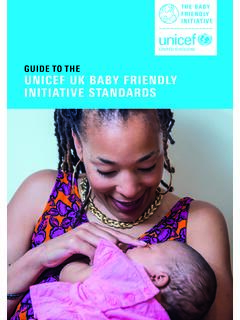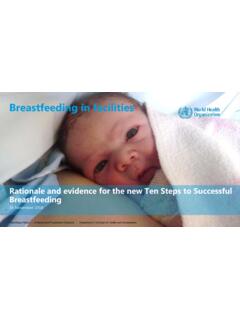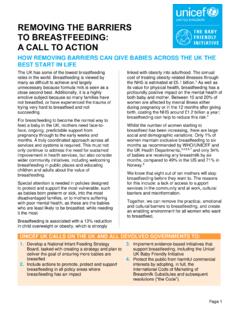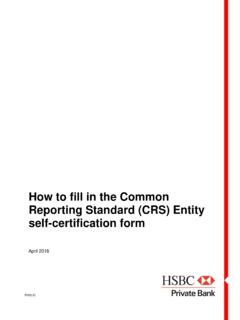Transcription of Hypoglycaemia of the Newborn - UNICEF UK
1 Guidance on the development of policies and guidelines for the prevention and management of Hypoglycaemia of the Newborn Hypoglycaemia Guidance, July 2013 1 Guidance on the development of policies and guidelines for the prevention and management of Hypoglycaemia of the Newborn Introduction Hospitals working towards the implementation of the WHO/ UNICEF Baby Friendly Initiative best practice standards often consider the development of guidelines for the prevention and management of Hypoglycaemia in the at risk infant. This is in order that breastfeeding may be protected by the avoidance of unnecessary supplementation with artificial milk, whilst ensuring the safety of all babies, irrespective of feeding If guidelines exist, it is important that they are effective and enable achievement of this goal. This document is intended to help hospitals to develop such guidelines.
2 It may be used to support the development of new guidelines or to decide whether the current guidelines will help the staff to practise in a way which will meet the standards for Baby Friendly accreditation. This document deals with key issues to be considered when devising guidelines for the prevention and management of Hypoglycaemia of the Newborn . These include the identification of babies who should be considered at risk , basic principles which should underpin all guidelines for their management, and the creation of an effective flow chart to guide day-to-day practice. The document includes a checklist which can be used as a way of evaluating the likely accuracy and effectiveness of existing or planned guidelines. Given that hospitals are at varied stages of implementing Baby Friendly best practice standards and have differing policies for deciding which babies are cared for in postnatal wards, development of one standard set of guidelines for all units would be unachievable.
3 Therefore, when adapting this guidance to your own area of work, it is vital that all safety measures be incorporated and that the completed policy be piloted for understanding among staff, ease of use, safety for all babies and protection of breastfeeding. Which babies are at risk ? Healthy term babies often feed infrequently in the first 24-48 hours after birth. Because they are able to mobilise energy stores through a process known as counter-regulation, they are unlikely to suffer any ill effects unless feed insufficiency is prolonged. Some babies, however, are less able to mount this response, for example those born preterm, small for gestational age, compromised at birth or who have neonatal infection or metabolic disorder. In addition, babies born to diabetic mothers may initially produce too much insulin, rendering them prone to lower blood glucose levels and mobilise energy stores.
4 A prolonged period of Hypoglycaemia , particularly if associated with clinical signs ( symptomatic Hypoglycaemia ) may lead to neurological impairment. It should not be assumed that only breastfed babies are at risk. Babies fed with infant formula and who fall into the at risk category should also be monitored closely, and their mothers supported with effective feeding. Hypoglycaemia Guidance, July 2013 2 Writing the guidelines Well written guidelines provide a strong foundation for the implementation and maintenance of best practice standards for breastfeeding. Therefore, it is essential that these documents are presented in a way which provides clear instruction to the staff members who have the task of implementing them. When making decisions about the management of the at risk baby staff often face a dilemma between protecting breastfeeding and ensuring the baby s nutrient intake is adequate.
5 Risks are that as a result, breastfed babies who require infant formula may not receive it or, alternatively, infant formula may be given unnecessarily. Similarly, without clear guidance, staff may underestimate the risk of Hypoglycaemia faced by vulnerable formula fed babies and Hypoglycaemia may be ineffectively prevented or managed. When developing guidelines for the prevention and management of Hypoglycaemia , it is vital to involve all disciplines and staff groups affected, as this will enhance acceptance and adherence. Education of staff in how to implement the guidelines is also essential. Audit of the effectiveness of the guidelines, including admission rates to NNU and the use of supplementary feeds for breastfed babies will enable assessment of the effectiveness of the guidelines. Although the exact scope and wording of the guidelines will vary from hospital to hospital, certain key principles should underpin them: Hypoglycaemia guidelines - Underpinning principles Babies who are at risk need to be correctly identified and managed appropriately.
6 For all breastfed babies, the aim should be to ensure that needs are met as far as possible by breastfeeding, or by the use of expressed colostrum/breastmilk (EBM). Exclusive breastfeeding optimises health outcomes. Also, it appears that breastmilk enhances the baby s ability to counter-regulate whereas large volumes of infant formula suppress this ability. If the baby is unable to breastfeed effectively, the mother should be encouraged to express her milk in order to maximise her future lactation. For formula fed babies, the aim should be to ensure frequent, effective feeding. Effective, ongoing observation of the baby s condition is vital ineffective feeding may be a sign of illness. Ensuring that the baby exhibits a normal level of arousal is fundamental to this aim. The baby should be woken and lifted from the cot to enable effective assessment of level of consciousness.
7 Blood glucose measurements taken prior to 2 hours of age are not informative readings made immediately after birth are merely indicative of the mother s blood glucose concentration. Levels may then drop sharply until counter-regulation is initiated. If blood glucose levels remain lower than the agreed acceptable minimum despite breastfeeding/EBM, the baby should be reviewed by a paediatrician with a view to further investigation and appropriate management. If a baby has abnormal clinical signs, urgent review by a paediatrician should be sought. Hypoglycaemia Guidance, July 2013 3 Guidelines such as these refer to the at risk baby who is deemed well enough to be cared for in the postnatal ward. Should any baby develop clinical signs of Hypoglycaemia , such as altered level of consciousness, abnormal tone or seizures, this can indicate underlying illness.
8 In these babies the acceptable threshold level for blood glucose concentration needs to be higher; they should be reviewed by the paediatrician urgently and should not remain in the postnatal ward. Creating an effective flowchart Information presented in a simple flowchart which takes the reader from one action to the next offers the optimum way of ensuring that effective care is given consistently. When devising a flowchart, consider the following: Recognition and management of the at-risk baby Are the language and requirements easily understood by staff? test the flow chart on junior staff. Is the layout logical do actions start at the beginning and move through the stages required? Are all possible actions covered? test the flow chart on a variety of real baby scenarios. Is it easy to read? consider tired night staff.
9 Does the flow chart consider the continued safety of the baby once the at risk period has elapsed? A flowchart can be found at the end of this document. Self-evaluation checklist The checklist below is provided for comparison against existing or planned guidelines, to help ensure that all essential points are covered and that best practice is reflected wherever possible. Guidance notes are included in the right-hand column. The checklist is in five sections: Essential points for all at risk babies Recommended practices at birth Recommended practices to support breastfeeding Care for formula fed babies Ensuring accurate and effective blood glucose monitoring Compare your guidelines with the checklist and decide whether, in your guidelines, each point is covered clearly, partially or ambiguously (unclear) or not covered at all and put a tick in the appropriate column.
10 Essential points for all at risk babies Point is (tick one): Point no. Essential point Covered clearly Unclear Not covered Guidance notes 1 The guidelines are written in the expected Trust format and include a review date To ensure compliance with Trust policy and CNST requirements 2 Guidelines apply to all staff As with all guidelines, all staff irrespective of role are expected to follow the suggested plan of care and document the reason for any deviation from the guideline. 3 Documentation: the guideline makes clear what documentation is required time, clinical signs noted, blood glucose concentration, treatment, response to treatment Neonatal Hypoglycaemia may be an early sign of other significant disease processes requiring further investigation and treatment ( infection). Therefore accurate documentation is essential.











